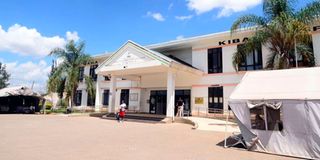Premium
Report: Respiratory, diarrheal and skin diseases top 3 causes of death in Nairobi

Mama Lucy Kibaki Hospital in Nairobi on December 22, 2020.
Respiratory, diarrheal and skin diseases are the top three causes of death in Nairobi County.
This is according to a report by the Health Taskforce Committee appointed by Governor Johnson Sakaja in September to look into ways of improving health service delivery in Nairobi.
Other killer diseases are pneumonia, malaria, urinary tract infections, ear infection, typhoid fever, dental disorders and accidents.
According to the team led by Dr Githinji Gitahi, the unemployment rate and job security are some of the reasons some city dwellers contract these diseases, leading to their deaths.
The high cases of communicable diseases have been linked to unhealthy living conditions among Nairobi residents.
Dr Gitahi said the deaths are associated with environmental health risk factors, including air pollution, congested and poorly ventilated dwellings, poor drinking water quality, sanitation and hygiene.
"Due to poor water, sanitation and hygiene, more than half the population is at risk of contracting diseases and death, with over 75 per cent of the country's disease burden caused by poor personal hygiene, inadequate sanitation practices and unsafe drinking water," the report read.
According to Kenya's population and housing census 2019, about 4.3 million people live in Nairobi. The city has over seven million people who come from neighbouring counties to work in the city during the day.
There are only 119 public health facilities in Nairobi. (59 level 2, 45 level 3, 12 level 4 and 3 level 5) while private and faith-based hospitals make up 85 per cent of the health facilities in the county.
According to the report, the available facilities need to be more staffed and stocked with drugs and crucial medical equipment like Intensive Care Units.
The county government is responsible for managing county health facilities, ambulance services, promotion of primary health care, disease surveillance and response, public health and sanitation, disaster management and waste disposal.
Nairobi County has a total of 803 health facilities, most privately owned. Public health facilities account for 15 per cent (119) of the total health facilities, while faith-based organisations and private facilities account for the rest of the 85 per cent.
The team found the few public health facilities in the county, which are overstretched, with over 150 per cent admission rate, forcing patients to share beds.
"The facilities also experience a frequent breakdown of medical equipment such as laboratory equipment and X-Ray machines due to lack of clear schedule of preventive maintenance, leading to long downtimes and disruption of services delivery,"
On the state of the health facilities, the team found out that some old buildings are unsuitable for healthcare settings and need to be refurbished.
"Poor maintenance and non-repair of health facilities attributed to poor planning, inadequate budget allocation for maintenance and lack of preventative maintenance schedule and culture leading to frequent breakdowns of equipment and dilapidated buildings," the report noted.
The Taskforce further discovered that various development projects initiated by the previous administrations have since stalled.
"Such projects are derailing service provision since they were earmarked to expand and improve the service delivery. The new hospitals have not been fully staffed, equipped and stocked with the necessary health products and technologies to ensure delivery of quality healthcare services to the public," Dr Gitahi said.
The team recommended the completion and equipping of public facilities to ensure they operate 24/7, and procure and install biometric equipment for all 119 health facilities.
Other recommendations include improving emergency services. The report says eight ICU/HDU beds should be set up at Mama Lucy Kibaki Hospital, eight at Pumwani, eight at Mbagathi and 12 at Mama Margaret Kenyatta Hospital in Korogocho.
The task force father recommends that the county should set up four blood banks and review the blood donation policy while establishing a fully-fledged blood satellite at Mama Lucy Kibaki Hospital.
The report also says the Sakaja administration should set up a sustainable and effective referral and linkage system for emergency and non-emergency services.
The team also recommends strengthening mental health services and establishing a centre of excellence in mental health.
Mr Sakaja said he would appoint a technical advisory committee to help him implement the recommendations of the report.
"I want to commit that the report will not be put on the shelves of our offices, but I will see to it that all the recommendations made by the task force are implemented for the benefit of Nairobians," he said.





